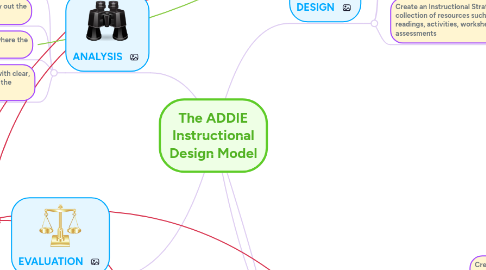
1. ANALYSIS
1.1. Develop clear instructional goals for the course/module
1.2. List all steps necessary to carry out the instructional goals
1.3. Conduct learner analysis to know where the learners stand
1.4. Create learning objectives with clear, measurable action verbs for the course/module
2. IMPLEMENTATION
2.1. Train the Instructor
2.1.1. Familiarize the instructor with learning objectives, materials, activities, assessments
2.2. Prepare the Learners
2.2.1. Ensure learners have all the knowledge and tools required for the class
2.2.1.1. Class schedule
2.2.1.2. Knowledge of LMS
2.2.1.3. Copies of content material
2.3. Arrange the Learning Space
2.3.1. Test all details of the learning space such as tools, hardware, multimedia equipment
3. EVALUATION
3.1. Formative Evaluation
3.1.1. Happens during each phase of ADDIE
3.2. Summative Evaluation
3.2.1. Conducted after the implementation phase
4. DEVELOPMENT
4.1. Create a Sample Instruction and verify with the client
4.2. Develop the course materials
4.2.1. Use the Instructional Strategy and Sample Instruction created earlier to create course material
4.2.2. Once done, get material reviewed from client
4.3. Conduct a Run-Through
4.3.1. Real-time rehearsal of the course developed
5. DESIGN
5.1. Design assessments, keeping in mind the instructional goals and learner analysis
5.2. Choose a course format in which to present the course to learners (classroom, online, blended, etc.)
5.3. Create an Instructional Strategy, which is a collection of resources such as lectures, readings, activities, worksheets and assessments
5.3.1. Preinstructional Activities
5.3.1.1. A catchy discussion to spark learners' interest towards the lesson
5.3.1.2. Give an overview of the course objectives
5.3.2. Content Presentation
5.3.2.1. Plan on clear, concise content
5.3.2.2. Give relevant examples for better understanding
5.3.3. Learner Participation
5.3.3.1. Practice sessions
5.3.3.2. Continuous feedback
5.3.4. Assessment
5.3.4.1. Final Assessment (Created earlier)
5.3.4.2. Practice Assessments
5.3.4.3. Attitude Assessments
5.3.5. Follow through Activities
5.3.5.1. Review of the content covered

